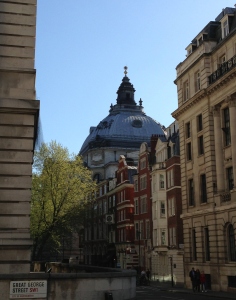Arriving in London’s St. Pancras station after a twenty-five year absence, the first of many changes that had overtaken the city since then began to wash over me like a wave. In 1989, work on the Channel Tunnel, following decades of planning, discussion, and ongoing set-backs, was in its very early stages. Back then it was still called the “Chunnel,” and its progress, or lack thereof, was daily tabloid fodder. The media eagerly fanned the flames of unease about the possibility of a land link to the Continent opening up a deadly rabies pipeline. Enormous, rambling St. Pancras had sat largely derelict. With its brooding red-brick towers and aura of neglect, it could have been mistaken for a Victorian mental asylum. It was gratifying to see how beautifully the station had been restored and updated to accommodate the Eurostar line. Had it been in a U.S. city, it more likely would have met the wrecking ball than renovation.
Emerging onto the streets of London, a less welcome transformation confronted me. The classic, classy black cabs–those timeless Hackney carriages–where were they? I knew they still existed, in a somewhat updated form, and in colors other than black. But the streets outside the station swarmed with garish purple and orange minivans. We could have been in Cleveland. We settled for one such vehicle to take us to our hotel on Grosvenor Square. Oh well.
One thing that had not changed, however, was the near-anarchic state of London’s traffic, which tends to be particularly alarming upon first arriving. Cars, motorcycles, bicycles and pedestrians are constantly darting aggressively from unexpected directions, especially at round-abouts. About half the vehicles appear to be confused by the concept of left-side driving. Our driver was frequently outraged at the ignorance and rudeness of others on the road. Some things, then, never change. In comparison, Paris’s streets were those of a sleepy backwater.
As we made our way through the chaotic congestion, in sudden fits and stops, I caught a glimpse of the new British Library next door to St. Pancras. When I left the U.K, it had been no more than a hazy, perhaps-some-day project. Most of my daily dissertation research had taken place in the manuscript room of the old library, then part of the British Museum on Great Russell Street. Less often, I worked under the vast grand dome of the historic main reading room. The new facility, perhaps a model of sleek twenty-first century efficiency, struck me as lacking in charm.
But it didn’t matter. It’s highly unlikely that I’ll ever turn the brightly painted and gilded pages of a fourteenth-century Apocalypse again, in the new library or elsewhere. I had abandoned my academic ties, let all those bridges quietly smolder away to ashes. I’d come to the conclusion, as I was finishing my dissertation, that a career in college teaching wasn’t for me. That was fortunate, since jobs in my field were extremely rare. I have no regrets about the course my life has taken. Do I? No, I don’t.
But I do miss the chance to page through those amazing medieval books, written and illustrated by hand. Their quirky images, typically more humorous than frightening, despite the accompanying text of Revelations: the dragons that resemble perky, pointy-eared dogs sitting for treats (in my mind, now, I see Kiko in every one), and the New Jerusalem descending from heaven, looking like a Gothic princess’s dream doll house. I can point out some of the books to my daughter, although they’ll have to remain safely inside their hermetically sealed glass display cases. See this one? I studied it. I had it in front of me for an entire week. It was removed from display so I could examine it! I think she’d be impressed. Someday, I’ll show her. But probably not on this trip.

